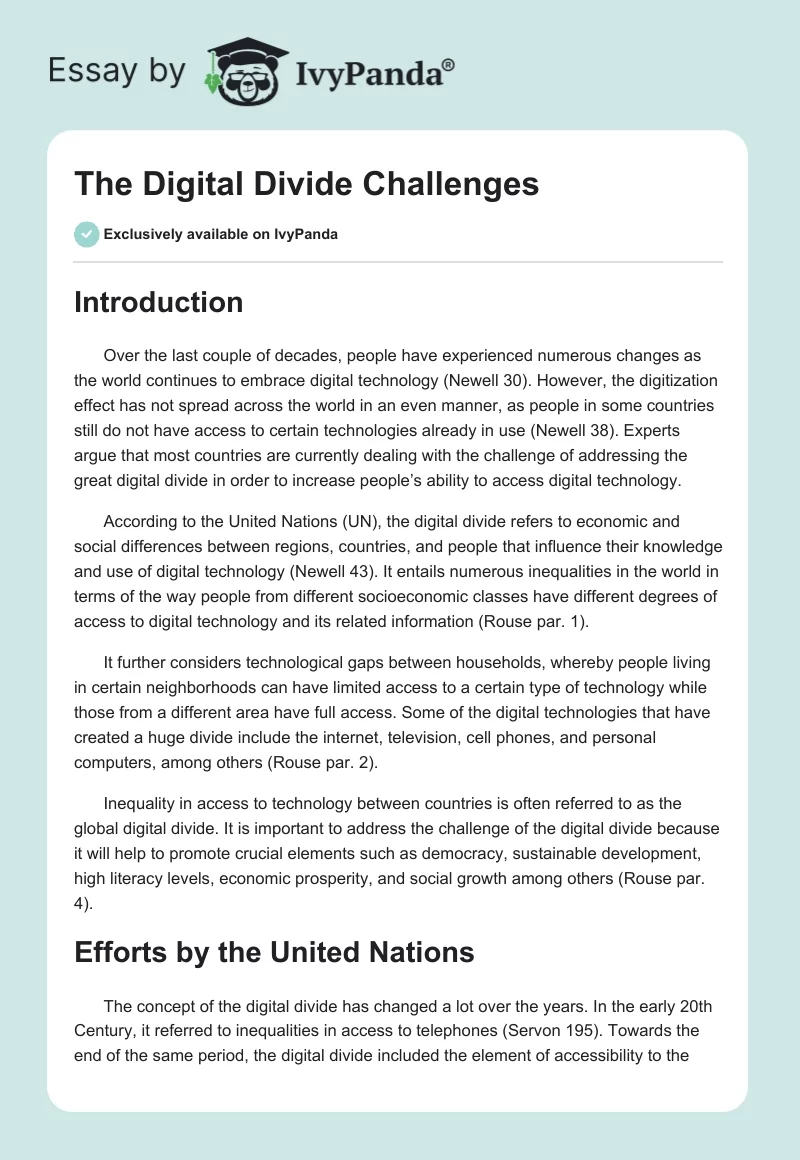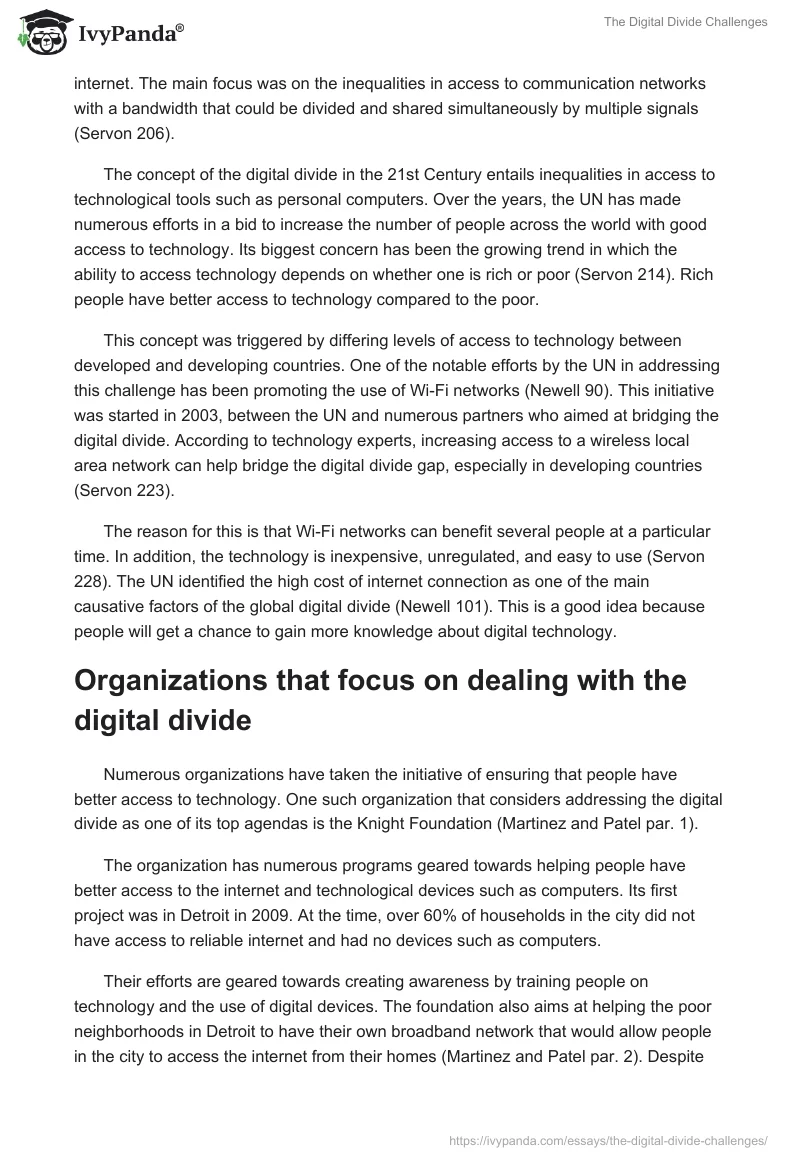Introduction
Over the last couple of decades, people have experienced numerous changes as the world continues to embrace digital technology (Newell 30). However, the digitization effect has not spread across the world in an even manner, as people in some countries still do not have access to certain technologies already in use (Newell 38). Experts argue that most countries are currently dealing with the challenge of addressing the great digital divide in order to increase people’s ability to access digital technology.
According to the United Nations (UN), the digital divide refers to economic and social differences between regions, countries, and people that influence their knowledge and use of digital technology (Newell 43). It entails numerous inequalities in the world in terms of the way people from different socioeconomic classes have different degrees of access to digital technology and its related information (Rouse par. 1).
It further considers technological gaps between households, whereby people living in certain neighborhoods can have limited access to a certain type of technology while those from a different area have full access. Some of the digital technologies that have created a huge divide include the internet, television, cell phones, and personal computers, among others (Rouse par. 2).
Inequality in access to technology between countries is often referred to as the global digital divide. It is important to address the challenge of the digital divide because it will help to promote crucial elements such as democracy, sustainable development, high literacy levels, economic prosperity, and social growth among others (Rouse par. 4).
Efforts by the United Nations
The concept of the digital divide has changed a lot over the years. In the early 20th Century, it referred to inequalities in access to telephones (Servon 195). Towards the end of the same period, the digital divide included the element of accessibility to the internet. The main focus was on the inequalities in access to communication networks with a bandwidth that could be divided and shared simultaneously by multiple signals (Servon 206).
The concept of the digital divide in the 21st Century entails inequalities in access to technological tools such as personal computers. Over the years, the UN has made numerous efforts in a bid to increase the number of people across the world with good access to technology. Its biggest concern has been the growing trend in which the ability to access technology depends on whether one is rich or poor (Servon 214). Rich people have better access to technology compared to the poor.
This concept was triggered by differing levels of access to technology between developed and developing countries. One of the notable efforts by the UN in addressing this challenge has been promoting the use of Wi-Fi networks (Newell 90). This initiative was started in 2003, between the UN and numerous partners who aimed at bridging the digital divide. According to technology experts, increasing access to a wireless local area network can help bridge the digital divide gap, especially in developing countries (Servon 223).
The reason for this is that Wi-Fi networks can benefit several people at a particular time. In addition, the technology is inexpensive, unregulated, and easy to use (Servon 228). The UN identified the high cost of internet connection as one of the main causative factors of the global digital divide (Newell 101). This is a good idea because people will get a chance to gain more knowledge about digital technology.
Organizations that focus on dealing with the digital divide
Numerous organizations have taken the initiative of ensuring that people have better access to technology. One such organization that considers addressing the digital divide as one of its top agendas is the Knight Foundation (Martinez and Patel par. 1).
The organization has numerous programs geared towards helping people have better access to the internet and technological devices such as computers. Its first project was in Detroit in 2009. At the time, over 60% of households in the city did not have access to reliable internet and had no devices such as computers.
Their efforts are geared towards creating awareness by training people on technology and the use of digital devices. The foundation also aims at helping the poor neighborhoods in Detroit to have their own broadband network that would allow people in the city to access the internet from their homes (Martinez and Patel par. 2). Despite the organization’s numerous efforts, it is yet to fully achieve its objective of ensuring everyone in Detroit has access to a reliable internet connection.
This challenge has been caused by a number of limitations, as clearly outlined in the report that the foundation released after the end of the first phase of the project (Martinez and Patel par. 4).
Some of the notable challenges include digital illiteracy, lack of internet-enabled devices, financial barriers placed by internet providers, high costs for internet access, and lack of reliable partnerships (Martinez and Patel par. 5). This is a good idea because the private sector is doing its best to complement efforts by governments in dealing with the digital divide.
The digital divide in South Africa
South Africa is one of the developing countries that have made major milestones in dealing with the challenge of the digital divide. The country has tried to ensure that its citizens have good access to technology despite having numerous social, economic, and political challenges (Reece 100). The telecommunication industry in the country was created in 1958. Over the years, it has experienced a number of changes due to effective state policies geared towards promoting the growth of technology.
One of the most effective strategies that the country has used in bridging the digital divide is the liberalization of the telecommunication industry (Reece 109). This means that no company can enjoy the monopoly of the industry because the government has created an environment that encourages competition among different service providers. According to experts, this policy has helped to improve people’s accessibility to technology due to reduced costs (Reece 117).
Reports indicate that over the last couple of decades, the number of schools in South Africa with computers has been increasing at a high rate. In addition, 39% of schools in the country are already using computers for learning. The country has introduced computer literacy into its curriculum for both primary and secondary schools, as the need to prepare the children for the fast-changing digital world continues to grow (Reece 127).
Despite these efforts, the government still reckons that there is a lot to be done before reaching the digital milestones achieved by developed countries. This challenge has been heightened by the reluctant nature of political leaders in developing policies that will create a way for massive changes in the country’s policy on technological development (Reece 133).
Conclusion
Addressing the challenge of the digital divide is crucial in promoting democracy, sustainable development, high literacy levels, economic prosperity, and social growth, especially in developing countries. In order to bridge the digital divide, it is important to ensure that people have access to digital devices that can enable them to access the internet.
Without essential tools such as computers, it is hard to achieve the desired levels of digital literacy essential for bridging the gap. In addition, the high cost of installing Wi-Fi networks and accessing the internet is still high for most people, especially in developing countries.
Works Cited
Martinez, Jorge, and M. Patel. Five Lessons in Bridging the Digital Divide. 2012. Web.
Newell, Alan. Design and the Digital Divide: Insights from 40 Years in Computer Support for Older and Disabled People. San Francisco: Morgan &Claypool Publishers, 2011. Print.
Reece, Catherin. The Digital Divide in South Africa: Identifying Emerging Inequalities in Internet Access and Online Public Spheres. Cape Town: University of Cape Town, 2008. Print.
Rouse, Margaret. What is Digital Divide? 2014. Web.
Servon, Lisa. Bridging the Digital Divide: Technology, Community and Public Policy. New York: John Wiley & Sons, 2008. Print.


